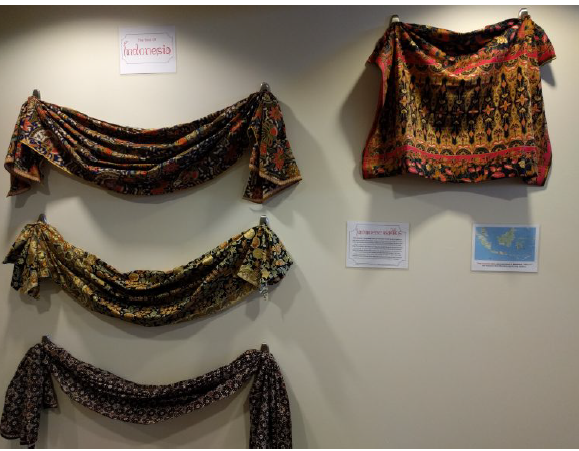There are so many opportunities to connect and interact with the Jennie King Mellon Library online and in person, and we recently added two more: Instagram and Spotify! Our new Instagram account (@jkmlibrary) features library news, updates, and shenanigans. Be sure to follow us for #NewBookTuesdays and #BookfaceFridays. You’ll also get to know our staff and librarians better, as we post fun pictures of our recommendations, displays, and exciting library life. And yes, you heard correctly, the library has a Spotify account. What is Spotify? It’s a music streaming service that allows those with accounts to listen to over 30 million songs for free and create and share playlists. Library staff members love music of all genres and styles. We’re hoping to share our love of music with the rest of the Chatham community in a way that enhances your experience at the library and allows you to get to know us better. Our playlists are specially crafted by librarians and library staff, and while they are certainly educational, they’re also a lot of fun. We create new playlists regularly for different purposes. A playlist could correspond with one of our in-library displays, be a Staff Spotlight playlist of recommendations put together by just one staff member, or something that our student workers have crafted! Our Native American Heritage Month book display is on the first floor of the JKM Library. Our most recent playlist is in honor of Native American Heritage Month, which is also the main book display in the library during the month of November. This playlist features more popular and recent musical artists from all across the genre spectrum that have Native/Indigenous heritage. It occurred to us that many non-native people do not realize the talent and influence of Native/Indigenous people (especially in music), so we wanted to craft a playlist that really brought that point across. Some included artists create music that draws very heavily from their roots, like Tanya Tagaq who has made Inuit throat singing cool again. Some artists are not widely known for their native heritage, like Joey Belladonna (lead singer of Anthrax) who is part Iroquois. Modern indigenous music takes on so many forms as well, from the protest songs of Buffy Sainte-Marie to the modern hip-hop of A Tribe Called Red and Frank Waln. The wide variety of music featured in our Native American Heritage Month playlist insures that there is something for everyone. We’ve got jazz singer Mildred Bailey, thrash metal band Testament, pop star Sky Ferreira, funk band Redbone… the list continues on in impressive fashion. Some of our selections are marked as explicit, which is important to note, but much of that content is speaking to injustices and rampant inequality. Sometimes oppression is met with anger through art, and that is still a valid expression. Get started listening below! If you aren’t able to listen to the playlist during November, don’t worry! We keep all the playlists we have crafted intact and available for continued listening. So what can you expect next? Later this month we have a highly anticipated Study Songs playlist, curated entirely by the JKM Library’s student workers. And you can expect the first of our Staff Spotlight playlists, featuring favorite selections from just one JKM Library staff member, to appear early in the new year. We hope that you enjoy our Spotify playlists as much as we do and can’t wait to see you on Instagram. Please be sure to follow us on all platforms for the most up-to-date information and recommendations. Happy reading and listening!
Commenting on blog posts requires an account.
Login is required to interact with this comment. Please and try again.
If you do not have an account, Register Now.
Every year, Chatham University chooses a Global Focus, and the 2017-2018 school year is the Year of Indonesia. In order to highlight Indonesian culture and society, the JKM Library has partnered with Dr. Greg Galford on displays that celebrate Indonesian culture and help educate our Chatham community. The first is a display of beautiful Javanese batiks purchased in Yogyakarta, Indonesia by Dr. Galford. Each of the batiks on display are incredibly beautiful, but one in particular features golden wax detailing that is truly stunning. The batik has been the source of some controversy over the years concerning the appropriation of Indonesian culture by many of its neighbors. A 2009 New York Times article detailed the struggle for cultural ownership of the batik between Indonesia and Malaysia. This was just one of many conflicts between the two nations. In September of that year, the United Nations Educational, Scientific and Cultural Organization, known as UNESCO, made the decision to add the batik to its Intangible Cultural Heritage list, meaning that its cultural meaning and significance is now protected and attributed to Indonesia (Gelling, 2009). According to UNESCO’s Intangible Cultural Heritage list, the batik is deeply rooted in Indonesian culture and plays a big part in the lives of Indonesians. Different intricate patterns are worn for everyday activities, special events, marriages, pregnancy, and other life events. Batiks feature at the birth of a child and the death of an elder. They are even incorporated into entertainment, such as puppet shows. The incredible designs drawn by craftsmen are indicative of the wide range of cultural influences Indonesia has been exposed to over the centuries. You will see elements of “Arabic calligraphy, European bouquets and Chinese phoenixes to Japanese cherry blossoms and Indian or Persian peacocks.” (Indonesian Batik, 2017) The process includes drawing beautiful designs on fabrics in hot wax which then helps to control which part of the fabric accepts the dyes and colors. This process is repeated on the same piece of fabric until the desired design is achieved (Indonesian Batik, 2017). The results are breath-taking. You can see video examples and up-close images of this process on UNESCO’s Intangible Cultural Heritage website. In another article by the New York Times that discussed the attempts to revive the batik tradition in the 1990s, batik historian T.T. Soerjanto explains how the tradition dates back 2,000 years and was first mentioned in the 15th century in the court records of Pakubuwono V, the King of Solo (Rabin, 1990). Take a look at the detailed fabric scans below of some of the batiks we have on display. Come in person to see our gilded batik in all its glory. You can find our batik display on the first floor of the library hanging on the wall partition near the elevator. Feel free to get up close and even touch the fabric, but please proceed with care. The second display is a collection of 18 books on Indonesia, provided by Dr. Galford. These books, which are both fiction and non-fiction, range in topic from history to civil engineering and infrastructure. While you are more than welcome to enjoy these books in the library, please do not remove them from the building. Below is a full list of titles in case you are interested in finding a copy for yourself! Under Construction: The Politics of Urban Space and Housing During the Decolonization of Indonesia by Freek Colombijn Island of Bali by Miguel Covarrubias Planet of Slums by Mike Davis The Traditional Architecture of Indonesia by Barry Dawson and John Gillow Balinese Dance, Drama & Music: A Guide to the Performing Arts of Bali by Wayan Dibia and Rucina Ballinger with illustration by Barbara Anello The Indonesia Reader: History, Culture by Tineke Hellwig and Eric Tagliacozzo The Year of Living Dangerously by Christopher J. Koch Behind the Postcolonial: Architecture, Urban Space and Political Cultures in Indonesia by Abidin Kusno The Appearance of Memory: Mnemonic Practices of Architecture and Urban Form in Indonesia by Abidin Kusno The Past in the Present: Architecture in Indonesia by Peter Nas Indonesia, Etc.: Exploring the Improbable Nation by Elizabeth Pisani Creative Batik by Rosi Robinson A Nation in Waiting: Indonesia’s Search for Stability by Adam Schwartz Indonesia: Peoples and Histories by Jean Gelman Taylor Indonesia: A Lonely Planet Travel Survival Kit by Justine Vaisutis Malay Archipelago by Alfred Russel Wallace The Living House: An Anthropology of Architecture in South-East Asia by Roxana Waterson Krakatoa: The day the world exploded by Simon Winchester We hope you enjoy Chatham’s Year of Indonesia! Take a moment to view our displays the next time you find yourself on the first floor of the JKM Library. References Indonesian Batik. (2017). Retrieved from https://ich.unesco.org/en/RL/indonesian-batik-00170 Gelling, P. (2009, September 14). Score One for Indonesia in the War Over Batik. The New York Times. Retrieved from http://www.nytimes.com/2009/09/15/world/asia/15iht-batik.html?mcubz=0 Rabin, R.C. (1990, February 18). The Intricate Patterning of Batik. The New York Times. Retrieved from http://www.nytimes.com/1990/02/18/travel/the-intricatepatterning-of-batik.html?pagewanted=all&mcubz=0




Some may wonder what the Euripides and Indigenous Heritage Month have in common. Others might ask what Chatham’s University Archives, which collects and preserves the history of the university, could have to help to connect the Athenian tragedian and campus-wide Indigenous Heritage events. Well, look no further than the Drama Department records from 1992 when students and faculty member Patricia Montley performed an adaptation of Euripides Trojan Woman set in Central America as Cortes seizes control of the Aztec empire. Publicity Photo, 1992 Chatham Theatre According to Dr. Motley’s program notes, a Euripedes’ The Trojan Woman is one of the most frequently performed of all the classical tragedies, particularly for audiences affected by war and in eras when war is celebrated. The decision to set the play in Central America in 1992, the 500-year anniversary of Columbus’ journey to the “New World,” allowed for reflection on “the foolishness of waging aggressive war and the transience of military might.” Program Cover for 1992 The Trojan Women Production The Trojan Women, Notes from the Adapter/Director, part 1 The Trojan Women, Notes from the Adapter/Director, part 2 It is fair to surmise that Chatham students, a generally politically-minded group, were quite aware of the impact of war, aggression, and gender-based power dynamics at play. The 1992 yearbook for includes four pages of reflection on current affairs, which included the US invasion of Iraq, an attempt to topple Gorbachev, and the appointment of Clarence Thomas to the US Supreme court. Click here and here to see the yearbook feature. Publicity Photo, 1992 Chatham Theatre The production included the performance of musical works by the Native Flute Ensemble and by Brooke Medicine Eagle. It was dedicated to Phyllis Ferguson, Drama Department faculty member from 1943 to 1970. Ms. Ferguson (left) in 1953 with students and Broadway actor Arnold Moss
Commenting on blog posts requires an account.
Login is required to interact with this comment. Please and try again.
If you do not have an account, Register Now.